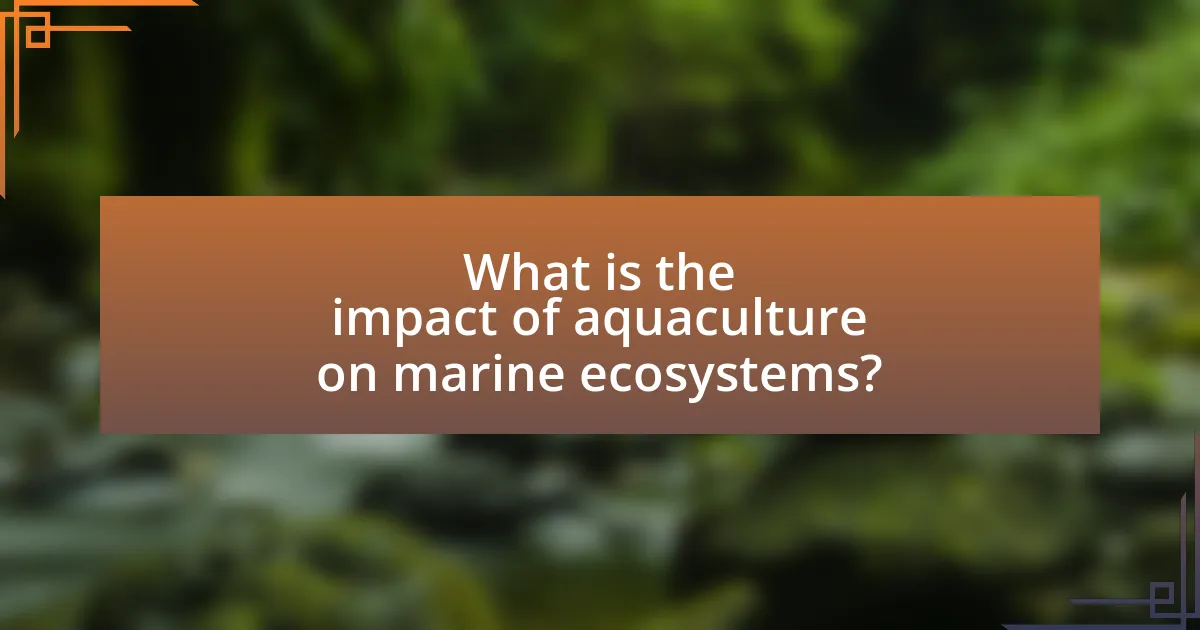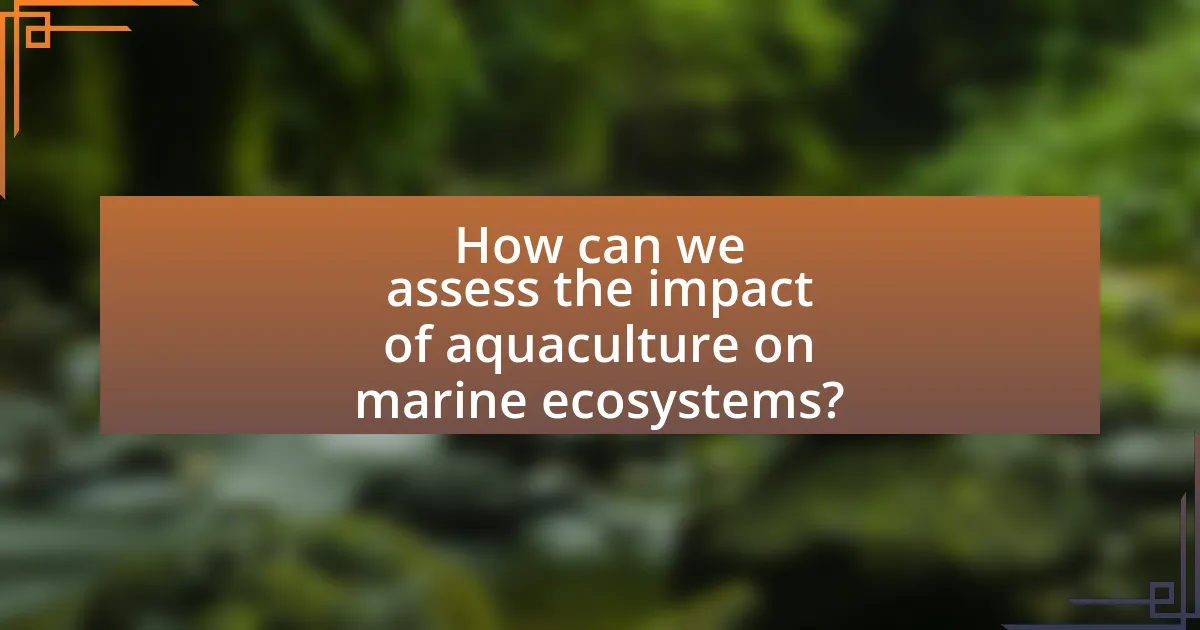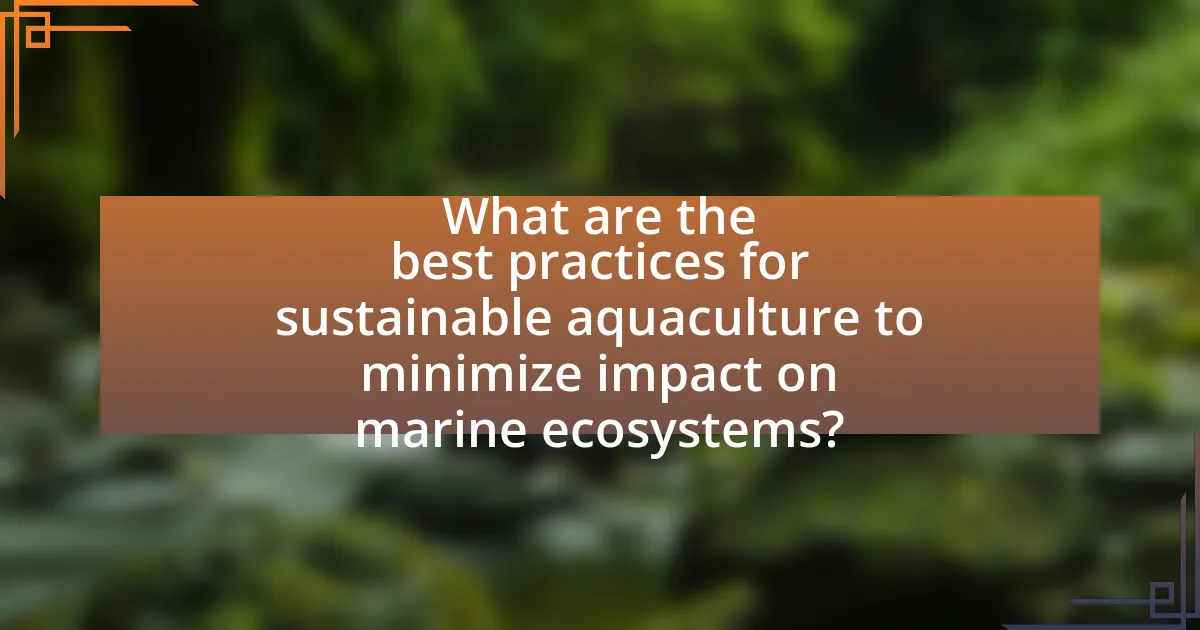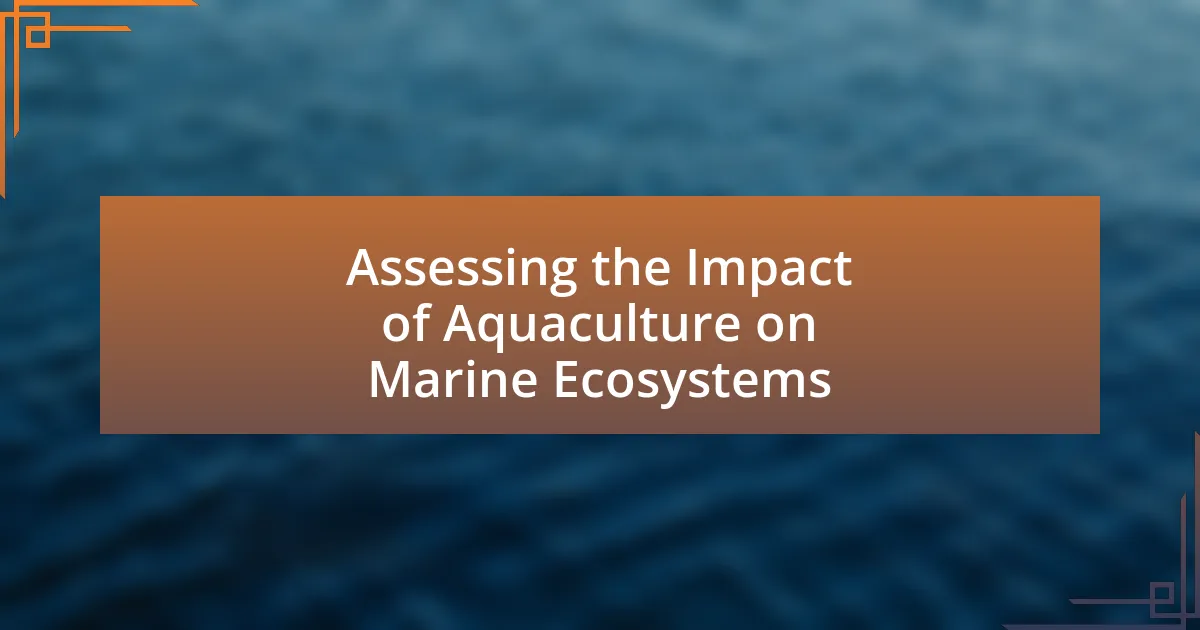Aquaculture, the farming of aquatic organisms, has a profound impact on marine ecosystems, influencing habitat structures, biodiversity, and water quality. This article examines the ecological consequences of aquaculture, including habitat degradation, nutrient pollution, and the effects on local fish populations and food webs. It also explores the socio-economic implications for fishing communities and the potential for sustainable practices to mitigate negative impacts. Key methodologies for assessing aquaculture’s effects, such as ecological monitoring and water quality analysis, are discussed, alongside best practices for integrating aquaculture with marine conservation efforts.

What is the impact of aquaculture on marine ecosystems?
Aquaculture significantly impacts marine ecosystems by altering habitat structures, introducing pollutants, and affecting biodiversity. The establishment of fish farms can lead to habitat destruction, particularly in coastal areas where mangroves and seagrasses are cleared for pond construction. Additionally, aquaculture operations often release excess nutrients and chemicals into surrounding waters, contributing to eutrophication, which can result in harmful algal blooms and dead zones. Studies indicate that aquaculture can lead to a decline in wild fish populations due to overfishing of forage species used as feed and the spread of diseases from farmed to wild fish. For instance, a report by the Food and Agriculture Organization (FAO) highlights that aquaculture production has increased significantly, with over 50% of global seafood now coming from farmed sources, raising concerns about its sustainability and ecological footprint.
How does aquaculture influence marine biodiversity?
Aquaculture influences marine biodiversity primarily by altering species composition and ecosystem dynamics. The introduction of farmed species can lead to genetic dilution of wild populations, as seen with the escape of farmed salmon into wild habitats, which can disrupt local ecosystems. Additionally, aquaculture practices often result in habitat modification, such as the conversion of mangroves and wetlands into fish farms, which diminishes biodiversity in those areas. Studies indicate that intensive aquaculture can lead to increased nutrient loading in surrounding waters, causing eutrophication that negatively impacts marine life. For instance, research published in “Marine Pollution Bulletin” highlights that nutrient runoff from aquaculture can lead to harmful algal blooms, further threatening marine biodiversity.
What species are most affected by aquaculture practices?
Aquaculture practices most significantly affect species such as wild fish populations, particularly those that are overfished like cod and haddock, as well as shellfish species including oysters and mussels. The introduction of farmed species, such as Atlantic salmon, can lead to genetic dilution and competition with wild counterparts. Additionally, the use of antibiotics and chemicals in aquaculture can impact local ecosystems, affecting non-target species and leading to biodiversity loss. Studies indicate that aquaculture can alter food webs and nutrient cycling, further stressing marine ecosystems.
How does aquaculture affect the food web in marine environments?
Aquaculture significantly alters the food web in marine environments by introducing large quantities of farmed species, which can disrupt natural predator-prey relationships. The introduction of species such as farmed fish can lead to increased competition for resources among native species, potentially resulting in declines in their populations. Additionally, the waste produced by aquaculture operations can lead to nutrient enrichment in surrounding waters, promoting algal blooms that further impact the food web by depleting oxygen levels and harming other marine life. Studies have shown that these changes can lead to shifts in species composition and abundance, ultimately affecting the overall health and stability of marine ecosystems.
What are the ecological consequences of aquaculture?
Aquaculture has significant ecological consequences, including habitat destruction, water pollution, and biodiversity loss. The establishment of fish farms often leads to the alteration or destruction of coastal ecosystems, such as mangroves and wetlands, which serve as critical habitats for various marine species. Additionally, the use of fertilizers and antibiotics in aquaculture can result in nutrient runoff and chemical contamination of surrounding waters, leading to harmful algal blooms and dead zones. Studies indicate that aquaculture can also introduce non-native species into local ecosystems, which may outcompete native species and disrupt existing food webs. For instance, the introduction of farmed species like Atlantic salmon into wild populations has been shown to negatively impact genetic diversity and survival rates of native fish.
How does aquaculture contribute to habitat degradation?
Aquaculture contributes to habitat degradation primarily through the alteration of natural ecosystems and the introduction of pollutants. The establishment of fish farms often leads to the destruction of coastal habitats such as mangroves and wetlands, which are critical for biodiversity. Additionally, the excessive use of feed and fertilizers in aquaculture operations can result in nutrient runoff, causing eutrophication in nearby water bodies. This process depletes oxygen levels, harming aquatic life and disrupting local ecosystems. Studies indicate that aquaculture can lead to a 50% reduction in biodiversity in affected areas, highlighting its significant impact on marine habitats.
What role does aquaculture play in nutrient pollution?
Aquaculture contributes significantly to nutrient pollution by releasing excess nutrients, particularly nitrogen and phosphorus, into aquatic ecosystems. These nutrients often originate from uneaten feed, fish waste, and fertilizers used in aquaculture operations. Studies indicate that nutrient runoff from aquaculture can lead to eutrophication, which causes harmful algal blooms and depletes oxygen levels in water bodies, adversely affecting marine life. For instance, research published in the journal “Marine Pollution Bulletin” highlights that aquaculture facilities can increase nutrient concentrations in surrounding waters by up to 10 times compared to natural levels, demonstrating the substantial impact of aquaculture on nutrient pollution.
What are the socio-economic implications of aquaculture on marine ecosystems?
Aquaculture significantly impacts marine ecosystems by altering biodiversity, water quality, and local economies. The introduction of farmed species can lead to genetic dilution of wild populations and disrupt local food webs. For instance, the escape of farmed salmon into wild populations has been shown to affect the genetic integrity of native salmonids, as documented in studies by the National Oceanic and Atmospheric Administration. Economically, aquaculture can provide job opportunities and increase food security, but it may also lead to overfishing of wild stocks for feed, as seen in the reduction of forage fish populations used in aquaculture feeds. This duality highlights the need for sustainable practices to balance economic benefits with ecological preservation.
How does aquaculture impact local fishing communities?
Aquaculture impacts local fishing communities by altering fish populations and economic dynamics. The introduction of farmed species can lead to competition with wild fish, potentially reducing their populations and affecting local fishermen’s catch. For instance, a study published in the journal “Marine Policy” found that in regions where aquaculture is prevalent, local fish stocks can decline by up to 30% due to overfishing and habitat degradation caused by farming practices. Additionally, aquaculture can provide alternative income sources for fishermen, but it may also lead to conflicts over resource use and access to fishing grounds.
What economic benefits does aquaculture provide to coastal regions?
Aquaculture provides significant economic benefits to coastal regions by creating jobs, generating income, and supporting local economies. The industry employs millions globally, with over 60 million people involved in aquaculture-related activities, contributing to livelihoods in coastal communities. Additionally, aquaculture contributes to food security and local food production, with global aquaculture production reaching over 114 million metric tons in 2020, valued at approximately $243 billion. This economic activity stimulates related sectors such as transportation, processing, and retail, further enhancing the economic landscape of coastal areas.

How can we assess the impact of aquaculture on marine ecosystems?
To assess the impact of aquaculture on marine ecosystems, researchers can utilize a combination of ecological monitoring, water quality analysis, and biodiversity assessments. Ecological monitoring involves tracking changes in species populations and community structures in areas surrounding aquaculture sites, which can reveal shifts in ecosystem dynamics. Water quality analysis measures parameters such as nutrient levels, oxygen content, and contaminants, providing insight into how aquaculture practices affect the surrounding environment. Biodiversity assessments evaluate the variety of species present, helping to identify any declines or alterations in local fauna and flora due to aquaculture activities. Studies, such as those published in the journal “Aquaculture,” have shown that poorly managed aquaculture can lead to nutrient pollution and habitat degradation, underscoring the importance of these assessment methods.
What methodologies are used to evaluate aquaculture’s effects?
Methodologies used to evaluate aquaculture’s effects include environmental impact assessments (EIAs), life cycle assessments (LCAs), and ecological modeling. EIAs systematically analyze the potential environmental consequences of aquaculture projects, providing a framework for decision-making. LCAs assess the environmental impacts associated with all stages of aquaculture production, from feed sourcing to fish harvesting, allowing for a comprehensive understanding of resource use and emissions. Ecological modeling simulates interactions within marine ecosystems, helping to predict the effects of aquaculture on biodiversity and ecosystem services. These methodologies are validated by numerous studies, such as the research conducted by the Food and Agriculture Organization, which emphasizes the importance of these assessments in sustainable aquaculture practices.
How do scientists measure biodiversity changes due to aquaculture?
Scientists measure biodiversity changes due to aquaculture primarily through ecological surveys and monitoring techniques. These methods include assessing species richness, abundance, and distribution in areas affected by aquaculture compared to control sites. For instance, studies often utilize underwater visual census methods, environmental DNA sampling, and remote sensing to quantify changes in species composition and habitat structure. Research has shown that aquaculture can lead to shifts in local biodiversity, with specific studies indicating that fish farming can alter community dynamics by introducing non-native species and affecting local populations. For example, a study published in “Marine Ecology Progress Series” by D. J. McGowan et al. (2020) demonstrated significant changes in benthic community structure near aquaculture sites, providing concrete evidence of biodiversity impacts.
What indicators are used to assess water quality in aquaculture areas?
Indicators used to assess water quality in aquaculture areas include dissolved oxygen levels, pH, temperature, turbidity, salinity, and concentrations of nutrients such as nitrogen and phosphorus. These indicators are critical for evaluating the health of aquatic environments, as they directly influence the growth and survival of aquatic organisms. For instance, dissolved oxygen levels below 5 mg/L can lead to hypoxia, adversely affecting fish and other marine life. Additionally, pH levels outside the range of 6.5 to 9.0 can stress aquatic organisms, while high turbidity can reduce light penetration, impacting photosynthesis in aquatic plants. Monitoring these indicators helps ensure sustainable aquaculture practices and minimizes negative impacts on marine ecosystems.
What role do policy and regulation play in assessing aquaculture impacts?
Policy and regulation are critical in assessing aquaculture impacts as they establish the legal framework and standards for environmental protection and resource management. These regulations guide the evaluation of ecological effects, ensuring that aquaculture practices do not harm marine ecosystems. For instance, the European Union’s Common Fisheries Policy mandates environmental assessments for aquaculture projects, which helps identify potential impacts on biodiversity and water quality. Additionally, regulations often require monitoring and reporting, enabling ongoing assessment of aquaculture’s effects on marine environments. This structured approach ensures that aquaculture development aligns with sustainability goals and mitigates negative impacts on marine ecosystems.
How do regulations influence sustainable aquaculture practices?
Regulations significantly influence sustainable aquaculture practices by establishing standards that promote environmental protection and resource management. These regulations often require aquaculture operations to adhere to guidelines that minimize ecological impacts, such as controlling water quality, managing feed inputs, and preventing the spread of diseases. For instance, the European Union’s Common Fisheries Policy mandates sustainable fishing practices, which extend to aquaculture, ensuring that operations do not deplete marine resources or harm ecosystems. Additionally, regulations can incentivize the adoption of innovative technologies and practices that enhance sustainability, such as integrated multi-trophic aquaculture, which utilizes waste from one species as feed for another, thereby reducing environmental footprints.
What are the challenges in enforcing aquaculture regulations?
Enforcing aquaculture regulations faces significant challenges, primarily due to the complexity of monitoring compliance and the diverse nature of aquaculture operations. Regulatory bodies often struggle with limited resources and manpower, making it difficult to conduct regular inspections and enforce standards effectively. Additionally, the rapid expansion of aquaculture practices can outpace regulatory frameworks, leading to gaps in oversight. For instance, a study by the Food and Agriculture Organization (FAO) highlights that many countries lack comprehensive legal frameworks to address environmental impacts, which complicates enforcement efforts. Furthermore, the transboundary nature of aquatic species and the global market for seafood can lead to illegal practices that are hard to trace and regulate.

What are the best practices for sustainable aquaculture to minimize impact on marine ecosystems?
The best practices for sustainable aquaculture to minimize impact on marine ecosystems include implementing integrated multi-trophic aquaculture (IMTA), using feed that is low in fishmeal and fish oil, and ensuring proper site selection to avoid sensitive habitats. IMTA promotes biodiversity by cultivating different species together, which can utilize waste products from one another, thereby reducing pollution. Utilizing feed with lower fishmeal content decreases reliance on wild fish stocks, which helps maintain marine biodiversity. Additionally, selecting sites that avoid critical habitats, such as mangroves and coral reefs, minimizes habitat destruction and preserves ecosystem integrity. These practices are supported by research indicating that sustainable aquaculture can significantly reduce environmental impacts while maintaining productivity.
How can aquaculture practices be improved for environmental sustainability?
Aquaculture practices can be improved for environmental sustainability by implementing integrated multi-trophic aquaculture (IMTA), which combines different species to utilize waste products as nutrients. This method reduces pollution and enhances resource efficiency, as demonstrated by a study published in the journal “Aquaculture” by Troell et al. (2009), which found that IMTA can significantly lower the environmental footprint of aquaculture operations. Additionally, adopting feed alternatives such as insect meal or plant-based proteins can decrease reliance on wild fish stocks, further promoting sustainability. Research from the Food and Agriculture Organization (FAO) indicates that transitioning to these sustainable feed sources can reduce the pressure on marine ecosystems while maintaining aquaculture productivity.
What techniques can reduce habitat destruction in aquaculture?
Techniques that can reduce habitat destruction in aquaculture include integrated multi-trophic aquaculture (IMTA), habitat restoration, and sustainable feed practices. IMTA promotes the cultivation of different species together, allowing waste from one species to serve as nutrients for another, thereby minimizing environmental impact. Habitat restoration involves rehabilitating damaged ecosystems, such as mangroves and seagrasses, which can enhance biodiversity and provide essential services. Sustainable feed practices, such as using plant-based feeds or by-products, reduce reliance on wild fish stocks, thereby lessening pressure on marine habitats. These methods collectively contribute to more sustainable aquaculture practices, as evidenced by studies showing that IMTA can improve ecosystem health and productivity while reducing nutrient pollution.
How can nutrient management be optimized in aquaculture systems?
Nutrient management in aquaculture systems can be optimized by implementing precision feeding techniques, which ensure that fish receive the exact amount of nutrients they require, thereby minimizing waste. Studies indicate that precision feeding can reduce feed waste by up to 30%, leading to lower nutrient loading in surrounding water bodies. Additionally, integrating biofilters and recirculating aquaculture systems can enhance nutrient uptake and reduce excess nutrients in the water. Research shows that these systems can decrease nitrogen and phosphorus levels significantly, improving water quality and reducing environmental impacts.
What are the benefits of integrating aquaculture with marine conservation efforts?
Integrating aquaculture with marine conservation efforts enhances biodiversity and promotes sustainable fish populations. This integration allows for the cultivation of fish species in controlled environments, reducing pressure on wild stocks and enabling the recovery of overfished species. For instance, the Marine Stewardship Council reports that sustainable aquaculture practices can lead to a 50% reduction in the environmental impact of seafood production. Additionally, aquaculture can contribute to habitat restoration, such as the cultivation of shellfish that filter water and improve ecosystem health. By aligning aquaculture practices with conservation goals, stakeholders can achieve a balance between food production and the preservation of marine ecosystems.
How can aquaculture support marine biodiversity conservation?
Aquaculture can support marine biodiversity conservation by providing a sustainable alternative to wild fishing, thereby reducing pressure on overexploited fish stocks. By cultivating species in controlled environments, aquaculture can help maintain population levels of various marine organisms, which is crucial for ecosystem balance. For instance, the cultivation of shellfish, such as oysters and clams, can enhance water quality and provide habitat for other marine life, promoting overall biodiversity. Additionally, integrated multi-trophic aquaculture (IMTA) systems, which combine different species at various trophic levels, can mimic natural ecosystems and improve nutrient cycling, further supporting marine biodiversity.
What collaborative approaches exist between aquaculture and environmental organizations?
Collaborative approaches between aquaculture and environmental organizations include joint research initiatives, sustainable certification programs, and habitat restoration projects. Joint research initiatives often focus on developing best practices that minimize environmental impacts, such as studies conducted by the World Wildlife Fund and various aquaculture companies to assess the ecological effects of fish farming. Sustainable certification programs, like the Marine Stewardship Council, promote responsible aquaculture practices that align with environmental conservation goals. Habitat restoration projects, such as those led by environmental NGOs in partnership with aquaculture firms, aim to rehabilitate coastal ecosystems affected by aquaculture activities, demonstrating a commitment to both industry growth and environmental stewardship.
What practical steps can stakeholders take to ensure sustainable aquaculture?
Stakeholders can ensure sustainable aquaculture by implementing best management practices, such as adopting integrated multi-trophic aquaculture (IMTA), which promotes biodiversity and reduces waste. IMTA systems utilize different species that complement each other, enhancing nutrient cycling and minimizing environmental impact. Research indicates that IMTA can improve overall productivity and reduce the reliance on external feed inputs, thus lowering the ecological footprint of aquaculture operations. Additionally, stakeholders should engage in regular monitoring and assessment of water quality and ecosystem health, as demonstrated by studies showing that proactive management leads to better sustainability outcomes. Implementing certification programs, such as the Marine Stewardship Council (MSC) standards, can also guide stakeholders in adhering to sustainable practices, ensuring that aquaculture operations meet environmental and social criteria.
